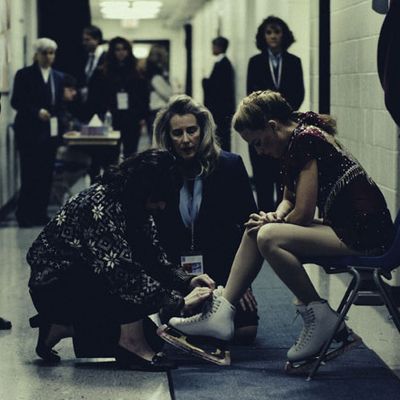
Unprepared viewers went to the Toronto International Film Festival premiere of I, Tonya expecting a white-trash take on I, Claudius, and came out dabbing at our tears, thinking, “Tonya was wronged!” That’s not exactly the movie’s take (no one person’s account is deemed wholly accurate) but Margot Robbie’s Tonya has so much more heart than the other characters that I forgave her everything that didn’t have to do with Nancy Kerrigan’s knee. Which she might have had nothing to do with. Or might not not have.
The movie’s structural gimmick is that the actors play their characters 25 years after the infamous “incident,” and each spins (bitterly) his or her own version of events. In some scenes, the characters even turn to the camera and say, “This is not what happened.” Sometimes the device works, sometimes it feels cheap. Harding’s story is compelling enough not to need those meta tricks.
What director Craig Gillespie and screenwriter Steven Rogers know for sure is that they have the mother of all bad mother stories. Said mother’s name is LaVona Golden and she’s played to howling effect by Allison Janney, with what The Drama of the Gifted Child author Alice Miller might describe as a perfect storm of narcissism. She’s a righteous saboteur. Janney purges the moistness from her voice, so she looks and sounds like the husk of a cicada you find sometimes in summer. Her very soul is desiccated. She shoves the teenage Tonya onto the ice, angry over her losses and jealous over her wins. “You skate like a graceless bull dyke,” she says. She hits, too. She’s violent enough to drive Tonya into the arms of the first man to tell her she’s pretty, Jeff Gillooly (Sebastian Stan), who unfortunately hits more often and harder. No wonder Tonya skates without smiling.
But skate she does, in defiance of judges who tell her she’s a bad fit for the sport — white trash, essentially. The real Tonya had a lot to overcome. She didn’t have the willowy, long-limbed frame of Kerrigan or more “classically” proportioned skaters. She got by on grit. Robbie is naturally more lithe than Harding and has to overcome her own handicap: the slimness and buoyancy that nature bestowed on her. But she and whatever doubles were used capture every bit of Harding’s driving athleticism. And Robbie evokes — superbly — how trapped Tonya must have felt. Her eyes seem to grow more dilated as the movie goes on, making her seem more outside herself. When, late in the film, you watch her apply her rouge too heavily, you see a woman longing to be storybook-pretty enough to transcend the ugliness around her.
There sure is a lot of ugliness. The ’70s and ’80s interiors are garish in that striving-for-sophistication way, and scenes are lighted and composed to look like those awful Polaroids that would develop (or half-develop) before your eyes. Stan’s Gillooly is the most insidious of abusers — he looks reasonable up to the instant the fist connects, and then he’s full of pleas and promises until the next whap. The mix of cartoonish idiocy and realistic domestic abuse is one of the film’s signatures, and it doesn’t entirely work. Seeing Tonya with black eyes and bruised cheeks and a split lip for the second or third time makes it hard to giggle at the antics of morons.
I, Tonya takes a particularly disjunctive turn when what everyone refers to as “the incident” is dramatized: Gillespie can’t resist making the freelance thugs look even stupider than they were, and Tonya’s noninvolvement means she briefly drops out of the movie and leaves us alone with cretins — among them the virulent mama’s (fat) boy Shawn Eckhardt (Paul Walter Hauser).
The Olympics climax is heartbreaking. Those of us who watched it live remember the sadistic pleasure of seeing Harding fall apart on the ice, in part thanks to the poetic revenge of a wayward shoelace. Experiencing that event from the other side made me ashamed at being part of a vast, jeering audience. Perhaps I’m overly gullible, but I now choose to buy the idea that someone other than Tonya Harding masterminded one of the dumbest schemes in Olympic sports. If she really — given all she knew about the stress on the human body after tens of thousands of hours of drilling — dispatched people to mutilate a fellow competitor, then the movie doesn’t capture it.
One thing that isn’t talked about enough vis-à-vis biopics is what a huge, huge, huge deal they become in the lives of their subjects who are still alive — milestones that never make it into the movies’ final crawls. The one for I, Tonya could conceivably read, “Tonya Harding’s life underwent a momentous change when she agreed to be interviewed for a sympathetic biopic starring Australian star Margot Robbie that portrayed her as the victim of a psychotically abusive mother and husband rather than an evil little scheming piece of white trash.” I have dreamed in classic Hollywood fashion of Harding’s comeback when I, Tonya is released: a standing O at the premiere and cries of “Tonya! Tonya!” on the Oscar’s red carpet. Anyone who said that in America there are no second acts didn’t account for the uncanny power of biopics.


